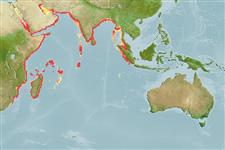Common names from other countries
Environment: milieu / climate zone / depth range / distribution range
Écologie
; saumâtre; profondeur 1 - 170 m (Ref. 8), usually 10 - 30 m (Ref. 8). Tropical, preferred 26°C (Ref. 107945); 30°N - 31°S, 29°E - 103°E
Indo-West Pacific and Southern Atlantic. Introduced in the Mediterranean. Tropical to subtropical.
Length at first maturity / Taille / Poids / Âge
Maturity: Lm 12.7, range 11 - 12 cm Max length : 19.9 cm TL mâle / non sexé; (Ref. 119750); 22.6 cm TL (female); âge max. reporté: 2.50 années (Ref. 104940)
Maximum carapace length: 5.0 cm (female; Ref. 8). Prefers bottom sandy mud (Ref. 8). Also occurs on seagrasses, mudflats, sandflats and mangrove channels. Frequently burrows (Ref. 106912). Feeds on crustaceans, polychaetes, mollusks, fishes, algae and detritus (Ref. 104916).
Mating behavior: Precopulatory courtship ritual is common (through olfactory and tactile cues); usually indirect sperm transfer (Ref. 833). Females spawn once every two (2) months (Ref. 104933).
Holthuis, L.B. 1980. (Ref. 8)
Statut dans la liste rouge de l'IUCN (Ref. 130435)
statut CITES (Ref. 108899)
Not Evaluated
Not Evaluated
Utilisations par l'homme
Pêcheries: commercial; appât: occasionally
FAO - pêcheries: landings | FishSource | Sea Around Us
Outils
Sources Internet
Estimates based on models
Preferred temperature
(Ref.
115969): 25.2 - 29.3, mean 27.8 (based on 258 cells).
Résilience
Haut, temps minimum de doublement de population inférieur à 15 mois (K=0.67-2.2; tmax=2.5).
Prior r = 1.11, 95% CL = 0.74 - 1.67, Based on 2 data-limited stock assessments.
Vulnérabilité
Low vulnerability (10 of 100).
